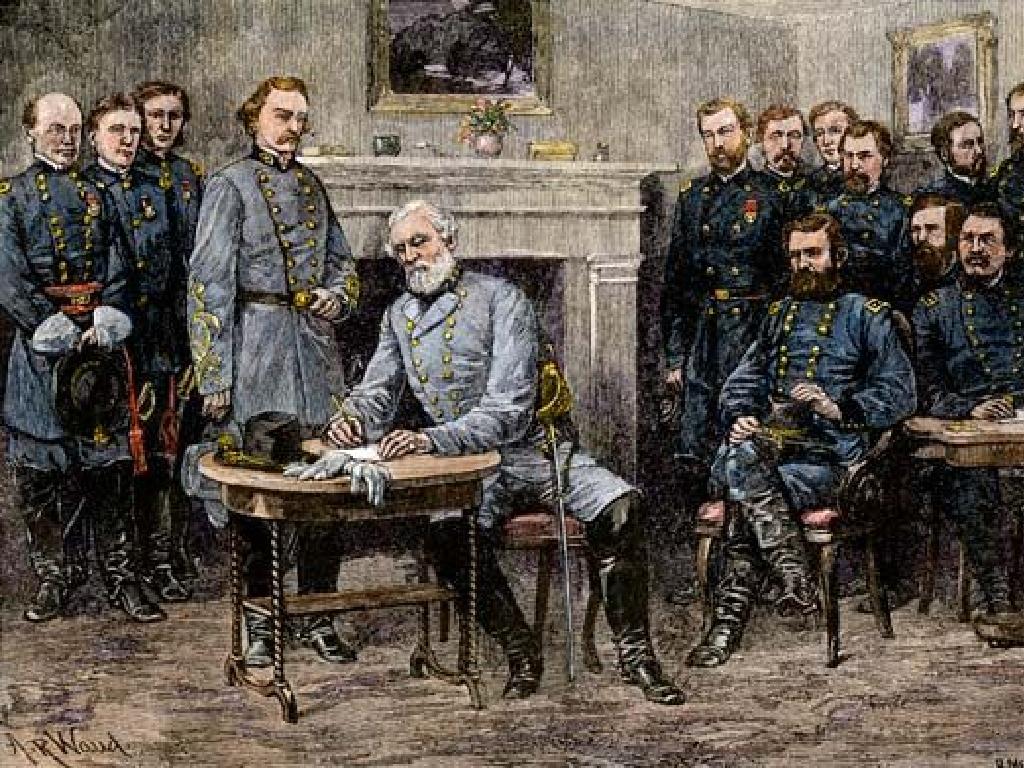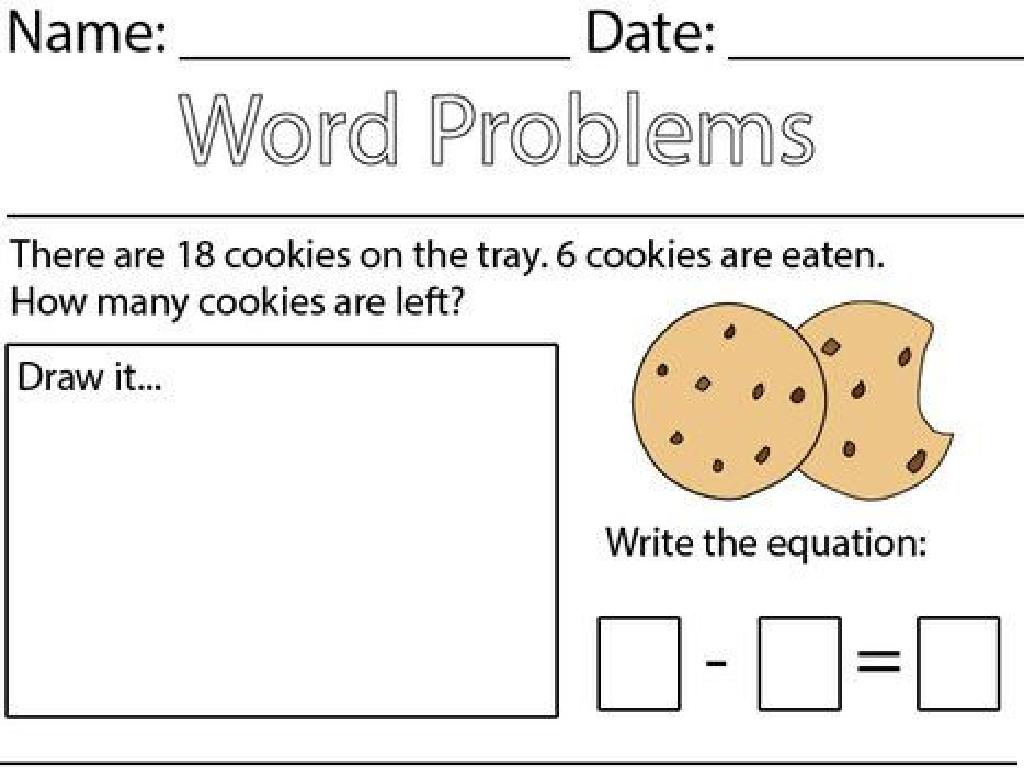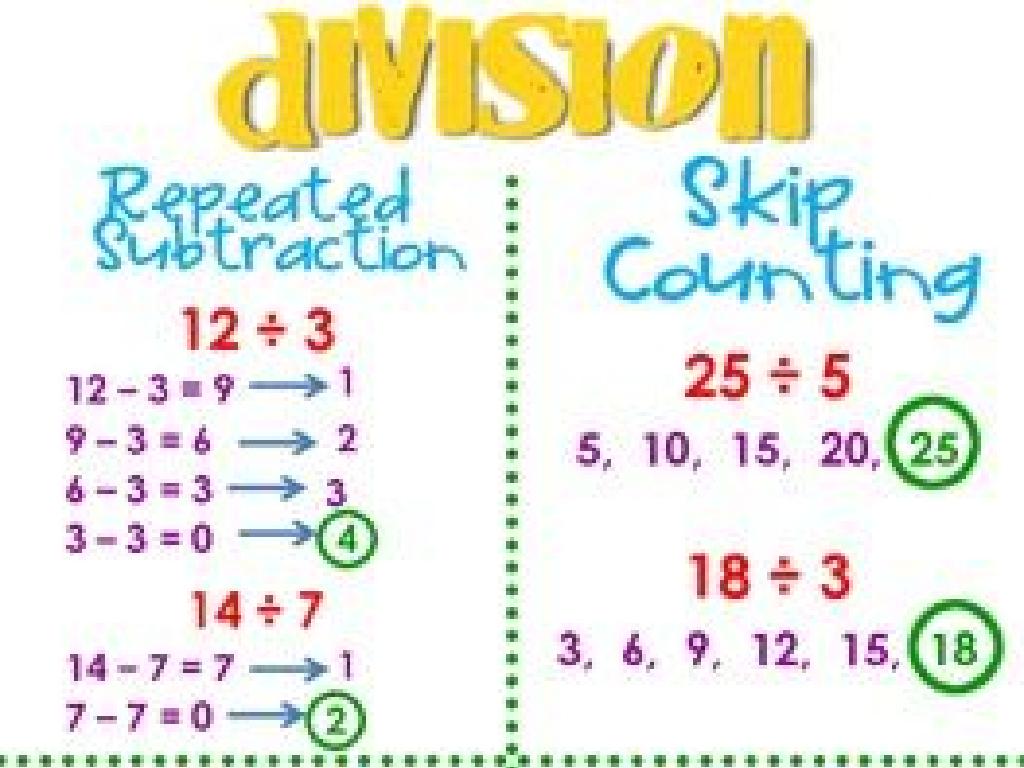Multiplicative Inverses
Subject: Math
Grade: Seventh grade
Topic: Operations With Fractions
Please LOG IN to download the presentation. Access is available to registered users only.
View More Content
Multiplicative Inverses in Fractions
– Everyday use of fractions
– Fractions are part of daily activities like cooking or dividing pizza.
– Multiplicative inverses explained
– A number times its multiplicative inverse equals 1, e.g., 3/4 * 4/3 = 1.
– Dividing fractions with inverses
– To divide by a fraction, multiply by its inverse: a/b ÷ c/d = a/b * d/c.
– Practice with real examples
|
This slide introduces the concept of multiplicative inverses within the context of fractions, a key component of seventh-grade mathematics. Begin by discussing how fractions are used in everyday life, such as in recipes or splitting items evenly among people, to make the concept relatable. Explain that the multiplicative inverse of a fraction is what you multiply the fraction by to get a product of 1. This is crucial for understanding how to divide fractions, as division by a fraction is the same as multiplication by its inverse. Provide examples for the students to work through, such as dividing a half of a pizza by a quarter of a pizza, to solidify their understanding. Encourage students to think of their own examples and share how they might use multiplicative inverses in real-life situations.
Understanding Multiplicative Inverses
– Define Multiplicative Inverse
– A number’s ‘flip side’ that results in 1 when multiplied together
– Concept of ‘flip side’
– Example: Inverse of 5
– Multiplying 5 and 1/5 gives us 1
– Example: Inverse of 1/5
– Multiplying 1/5 and 5 also gives us 1
|
The concept of a multiplicative inverse is fundamental in understanding operations with fractions. A multiplicative inverse is essentially a reciprocal; when a number is multiplied by its reciprocal, the result is 1. This is often referred to as the ‘flip side’ of a number. For example, the inverse of 5 is 1/5 because when 5 is multiplied by 1/5, the product is 1. Similarly, the inverse of 1/5 is 5. It’s important for students to grasp this concept as it is widely used in solving equations and working with fractions. Encourage students to find the multiplicative inverse of various numbers and to verify by multiplication that the product is indeed 1.
Multiplicative Inverses and Fractions
– Finding the inverse of a fraction
– To find the inverse, simply exchange the top and bottom numbers of the fraction.
– Flip the numerator and denominator
– Flipping makes the original fraction’s product with its inverse equal to 1.
– Example: Inverse of 3/4
– The inverse of 3/4 is 4/3; when multiplied together, they equal 1.
– Multiplicative identity: 1
|
This slide introduces the concept of multiplicative inverses in the context of fractions. To find the inverse, also known as the reciprocal, students should flip the numerator (top number) and the denominator (bottom number) of the fraction. For example, the inverse of 3/4 is 4/3. When a fraction is multiplied by its inverse, the result is the multiplicative identity, which is 1. This is a fundamental property in mathematics that helps in solving equations and understanding proportional relationships. Encourage students to practice with different fractions to solidify their understanding of this concept.
Dividing Fractions with Multiplicative Inverses
– Divide by multiplying with the inverse
– Instead of dividing directly, multiply by the reciprocal of the divisor.
– Multiplying by inverse equals division
– When you multiply a number by its reciprocal, you get 1. This is why the method works.
– Example: Dividing 1/2 by 3/4
– To divide 1/2 by 3/4, multiply 1/2 by the reciprocal of 3/4, which is 4/3.
|
This slide explains the concept of using multiplicative inverses, or reciprocals, to divide fractions. The key takeaway is that division can be turned into multiplication by using the reciprocal of the divisor. For example, dividing 1/2 by 3/4 is the same as multiplying 1/2 by 4/3. This method simplifies the division of fractions and is a fundamental skill in algebra. Encourage students to practice this technique with various fractions and to understand the underlying reason why it works, reinforcing their comprehension of fraction operations.
Let’s Practice Together: Multiplicative Inverses
– Find the inverse of fractions
– Inverse of a/b is b/a. For example, the inverse of 2/3 is 3/2.
– Divide fractions with inverses
– To divide by a fraction, multiply by its inverse. E.g., 4/7 ÷ 2/3 = 4/7 * 3/2.
– Pair up for group activity
– Solve practice problems together
– Work in pairs to reinforce understanding through collaboration.
|
This slide is designed for a collaborative classroom activity to practice finding and using multiplicative inverses. Start by explaining that the multiplicative inverse of a fraction is simply flipping the numerator and denominator. Then, demonstrate how dividing by a fraction is the same as multiplying by its inverse. For the group activity, have students pair up and solve a set of practice problems that require them to find inverses and use them to divide fractions. Provide guidance and ensure each pair understands the concept before moving on to independent practice. Possible activities could include solving word problems, simplifying complex fractions, or creating their own problems for others to solve.
Real-World Applications of Multiplicative Inverses
– Multiplicative inverses in cooking
– Use inverses to scale recipes up or down
– Adjusting recipe portions
– If a recipe is for 4 people, how to adjust for 10?
– Inverses in construction work
– Inverses help determine the right mix of materials
– Calculating material proportions
– For a concrete mix, what’s the ratio of cement to sand?
|
Understanding multiplicative inverses is crucial in everyday life, especially in tasks that involve scaling and proportion. In cooking, for instance, we often need to adjust recipes based on the number of servings required. By using the multiplicative inverse, students can learn to scale the ingredients up or down accurately. In construction, calculating the correct proportions of materials like cement and sand is essential for the stability of the structure. Multiplicative inverses allow us to find the right balance for these mixtures. Encourage students to think of other areas where they might need to use multiplicative inverses and discuss the importance of precision in these calculations.
Class Activity: Fraction Scavenger Hunt
– Find objects representing fractions
– Determine each object’s inverse
– If an object represents 1/2, its inverse is 2/1
– Share findings with the class
– Understand inverses in real life
– Relate inverses to real-world objects
|
This interactive activity is designed to help students understand the concept of multiplicative inverses through a hands-on approach. Students will search the classroom for objects that can be represented as fractions, such as a half-eaten apple (1/2) or a pair of scissors (2/2). Once they find an object, they should determine its multiplicative inverse, which is the number that, when multiplied with the fraction, equals 1. For example, the inverse of 1/2 is 2/1. After finding and calculating the inverses, students will share their objects and inverses with the class, explaining how they determined the inverse. This will reinforce their understanding and provide a practical application of the concept. For the teacher: Prepare a list of possible objects and their corresponding fractions as a guide, and be ready to assist students who may struggle with finding the inverse or understanding the concept.
Wrapping Up: Multiplicative Inverses
– Recap: What are multiplicative inverses?
– Two numbers whose product is 1, e.g., 3/4 and 4/3
– Why fractions matter in math
– Understanding fractions is key to algebra and beyond
– Homework: Practice worksheet
– Complete the worksheet on finding and using inverses
– Be prepared to discuss solutions
– We’ll review the worksheet answers together
|
As we conclude today’s lesson, remind students that multiplicative inverses are pairs of numbers that multiply to give 1. This concept is crucial when working with fractions and solving equations in algebra. For homework, students will complete a worksheet to reinforce their understanding of how to find and use multiplicative inverses. Encourage them to attempt all problems and be ready to discuss their solutions in the next class. This practice will help solidify their grasp of the concept and prepare them for more advanced topics in mathematics.





